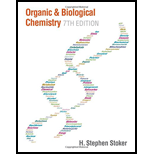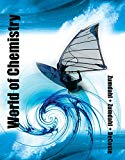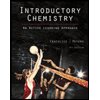
Organic And Biological Chemistry
7th Edition
ISBN: 9781305081079
Author: STOKER, H. Stephen (howard Stephen)
Publisher: Cengage Learning,
expand_more
expand_more
format_list_bulleted
Concept explainers
Textbook Question
Chapter 2, Problem 2.19EP
Draw a condensed structural formula for each of the following
- a. 3-Methyl-1-pentene
- b. 3-Methylcyclopentene
- c. 1,3-Butadiene
- d. 3-Ethyl-1,4-pentadiene
Expert Solution & Answer
Trending nowThis is a popular solution!

Students have asked these similar questions
List isomers of: a) cycloalkanes; b) ethers; c) esters: d) alkynes
Draw and name all of the structural isomers of a) pentane and b) hexane.
Which organic compound is unsaturated?
Question 11 options:
a.
ethylcyclopentane
b.
2-methyl-3-ethylpentyne
c.
1,1-dimethylhexane
d.
cyclohexane
Chapter 2 Solutions
Organic And Biological Chemistry
Ch. 2.1 - Prob. 1QQCh. 2.1 - Prob. 2QQCh. 2.1 - Prob. 3QQCh. 2.2 - Prob. 1QQCh. 2.2 - Prob. 2QQCh. 2.2 - Prob. 3QQCh. 2.2 - Prob. 4QQCh. 2.3 - Prob. 1QQCh. 2.3 - Prob. 2QQCh. 2.3 - Prob. 3QQ
Ch. 2.3 - Prob. 4QQCh. 2.4 - Prob. 1QQCh. 2.4 - Prob. 2QQCh. 2.5 - Prob. 1QQCh. 2.5 - Prob. 2QQCh. 2.5 - Prob. 3QQCh. 2.6 - Prob. 1QQCh. 2.6 - Prob. 2QQCh. 2.6 - Prob. 3QQCh. 2.7 - Prob. 1QQCh. 2.7 - Prob. 2QQCh. 2.7 - Prob. 3QQCh. 2.8 - Prob. 1QQCh. 2.8 - Prob. 2QQCh. 2.9 - Prob. 1QQCh. 2.9 - Prob. 2QQCh. 2.10 - Prob. 1QQCh. 2.10 - Prob. 2QQCh. 2.10 - Prob. 3QQCh. 2.10 - Prob. 4QQCh. 2.10 - Prob. 5QQCh. 2.11 - Prob. 1QQCh. 2.11 - Prob. 2QQCh. 2.11 - Prob. 3QQCh. 2.11 - Prob. 4QQCh. 2.11 - Prob. 5QQCh. 2.12 - Prob. 1QQCh. 2.12 - Prob. 2QQCh. 2.12 - Prob. 3QQCh. 2.12 - Prob. 4QQCh. 2.12 - Prob. 5QQCh. 2.13 - Prob. 1QQCh. 2.13 - Prob. 2QQCh. 2.13 - Prob. 3QQCh. 2.14 - Prob. 1QQCh. 2.14 - Prob. 2QQCh. 2.14 - Prob. 3QQCh. 2.14 - Prob. 4QQCh. 2.15 - Prob. 1QQCh. 2.15 - Prob. 2QQCh. 2.15 - Prob. 3QQCh. 2.15 - Prob. 4QQCh. 2.16 - Prob. 1QQCh. 2.16 - Prob. 2QQCh. 2 - Classify each of the following hydrocarbons as...Ch. 2 - Prob. 2.2EPCh. 2 - Prob. 2.3EPCh. 2 - Prob. 2.4EPCh. 2 - Prob. 2.5EPCh. 2 - Prob. 2.6EPCh. 2 - Prob. 2.7EPCh. 2 - Characterize the physical properties of saturated...Ch. 2 - Prob. 2.9EPCh. 2 - Prob. 2.10EPCh. 2 - Prob. 2.11EPCh. 2 - Prob. 2.12EPCh. 2 - Prob. 2.13EPCh. 2 - Prob. 2.14EPCh. 2 - What is the name of the spatial arrangement for...Ch. 2 - Prob. 2.16EPCh. 2 - Prob. 2.17EPCh. 2 - Prob. 2.18EPCh. 2 - Draw a condensed structural formula for each of...Ch. 2 - Prob. 2.20EPCh. 2 - The following names are incorrect by IUPAC rules....Ch. 2 - The following names are incorrect by IUPAC rules....Ch. 2 - Prob. 2.23EPCh. 2 - Draw a condensed structural formula for each of...Ch. 2 - Prob. 2.25EPCh. 2 - Classify each of the following compounds as...Ch. 2 - Prob. 2.27EPCh. 2 - How many hydrogen atoms are present in a molecule...Ch. 2 - Draw a line-angle structural formula for each of...Ch. 2 - Draw a line-angle structural formula for each of...Ch. 2 - Prob. 2.31EPCh. 2 - Prob. 2.32EPCh. 2 - Prob. 2.33EPCh. 2 - Prob. 2.34EPCh. 2 - Prob. 2.35EPCh. 2 - Prob. 2.36EPCh. 2 - Prob. 2.37EPCh. 2 - Prob. 2.38EPCh. 2 - For each of the following pairs of alkenes,...Ch. 2 - For each of the following pairs of alkenes,...Ch. 2 - Prob. 2.41EPCh. 2 - Prob. 2.42EPCh. 2 - Prob. 2.43EPCh. 2 - Prob. 2.44EPCh. 2 - Prob. 2.45EPCh. 2 - Prob. 2.46EPCh. 2 - For each molecule, indicate whether cistrans...Ch. 2 - Prob. 2.48EPCh. 2 - Prob. 2.49EPCh. 2 - Prob. 2.50EPCh. 2 - Draw a structural formula for each of the...Ch. 2 - Prob. 2.52EPCh. 2 - Prob. 2.53EPCh. 2 - For each of the following molecules, indicate...Ch. 2 - Prob. 2.55EPCh. 2 - Prob. 2.56EPCh. 2 - Prob. 2.57EPCh. 2 - Prob. 2.58EPCh. 2 - Prob. 2.59EPCh. 2 - How many isoprene units are present in a....Ch. 2 - Prob. 2.61EPCh. 2 - Indicate whether each of the following statements...Ch. 2 - Prob. 2.63EPCh. 2 - Prob. 2.64EPCh. 2 - Prob. 2.65EPCh. 2 - Prob. 2.66EPCh. 2 - Prob. 2.67EPCh. 2 - Prob. 2.68EPCh. 2 - Prob. 2.69EPCh. 2 - Prob. 2.70EPCh. 2 - Prob. 2.71EPCh. 2 - Prob. 2.72EPCh. 2 - Prob. 2.73EPCh. 2 - Prob. 2.74EPCh. 2 - Prob. 2.75EPCh. 2 - Prob. 2.76EPCh. 2 - Supply the structural formula of the product in...Ch. 2 - Prob. 2.78EPCh. 2 - Prob. 2.79EPCh. 2 - What reactant would you use to prepare each of the...Ch. 2 - Prob. 2.81EPCh. 2 - Prob. 2.82EPCh. 2 - Prob. 2.83EPCh. 2 - Prob. 2.84EPCh. 2 - Prob. 2.85EPCh. 2 - Prob. 2.86EPCh. 2 - Prob. 2.87EPCh. 2 - Prob. 2.88EPCh. 2 - Prob. 2.89EPCh. 2 - Prob. 2.90EPCh. 2 - Prob. 2.91EPCh. 2 - Prob. 2.92EPCh. 2 - Prob. 2.93EPCh. 2 - Prob. 2.94EPCh. 2 - Prob. 2.95EPCh. 2 - Prob. 2.96EPCh. 2 - Prob. 2.97EPCh. 2 - Prob. 2.98EPCh. 2 - Prob. 2.99EPCh. 2 - Prob. 2.100EPCh. 2 - Prob. 2.101EPCh. 2 - Prob. 2.102EPCh. 2 - Prob. 2.103EPCh. 2 - Prob. 2.104EPCh. 2 - Prob. 2.105EPCh. 2 - Prob. 2.106EPCh. 2 - Prob. 2.107EPCh. 2 - Prob. 2.108EPCh. 2 - Assign each of the compounds in Problem 13-107 an...Ch. 2 - Assign each of the compounds in Problem 13-108 an...Ch. 2 - Prob. 2.111EPCh. 2 - Prob. 2.112EPCh. 2 - Prob. 2.113EPCh. 2 - Prob. 2.114EPCh. 2 - Prob. 2.115EPCh. 2 - Prob. 2.116EPCh. 2 - Prob. 2.117EPCh. 2 - Prob. 2.118EPCh. 2 - Prob. 2.119EPCh. 2 - Prob. 2.120EPCh. 2 - Prob. 2.121EPCh. 2 - Prob. 2.122EPCh. 2 - Prob. 2.123EPCh. 2 - Prob. 2.124EPCh. 2 - Prob. 2.125EPCh. 2 - Prob. 2.126EPCh. 2 - Prob. 2.127EPCh. 2 - Prob. 2.128EPCh. 2 - Prob. 2.129EPCh. 2 - Prob. 2.130EP
Knowledge Booster
Learn more about
Need a deep-dive on the concept behind this application? Look no further. Learn more about this topic, chemistry and related others by exploring similar questions and additional content below.Similar questions
- The correct structural for ethyne is: a. HC=CH b. HC=C=H c. HCCH d. H=C=C=Harrow_forwardWhat is the molecular formula for a hydrocarbon with 23 carbons that is (a) completelysaturated; (b) an alkene; (c) an alkyne?arrow_forwardDraw the structure for each of the following: a. 3,3-dimethylcyclopentene b. 6-bromo-2,3-dimethyl-2-hexene c. ethyl vinyl ether d. allyl alcoholarrow_forward
- The reaction of an alkene with water produces what type of product? A) alkane B) alkyne C) alcohol D) aldehyde E) amino acidarrow_forwardRepresent, by a structural diagram, the following hydrocarbons a) Hexane b) 2-Methyl propane c) 2-Octene d) 3-Ethyl 4-methyl cycloheptenearrow_forwardExplain the role of London dispersion forces on the melting and boiling points of alkanes.arrow_forward
- Use the generic formula for alkanes (CnH2n+2) to derive molecular and condensed structural formulas for: a. Propane, 3 carbon atoms b. Octane, 8 carbon atoms c. Butane, 4 carbon atomsarrow_forwardWhat is the difference in bonding and in the general molecular formula between an alkene and an alkane with the same number of carbon atoms?arrow_forward
arrow_back_ios
arrow_forward_ios
Recommended textbooks for you
- Chemistry: Matter and ChangeChemistryISBN:9780078746376Author:Dinah Zike, Laurel Dingrando, Nicholas Hainen, Cheryl WistromPublisher:Glencoe/McGraw-Hill School Pub Co
 World of Chemistry, 3rd editionChemistryISBN:9781133109655Author:Steven S. Zumdahl, Susan L. Zumdahl, Donald J. DeCostePublisher:Brooks / Cole / Cengage Learning
World of Chemistry, 3rd editionChemistryISBN:9781133109655Author:Steven S. Zumdahl, Susan L. Zumdahl, Donald J. DeCostePublisher:Brooks / Cole / Cengage Learning
 Chemistry for Today: General, Organic, and Bioche...ChemistryISBN:9781305960060Author:Spencer L. Seager, Michael R. Slabaugh, Maren S. HansenPublisher:Cengage Learning
Chemistry for Today: General, Organic, and Bioche...ChemistryISBN:9781305960060Author:Spencer L. Seager, Michael R. Slabaugh, Maren S. HansenPublisher:Cengage Learning Introductory Chemistry: An Active Learning Approa...ChemistryISBN:9781305079250Author:Mark S. Cracolice, Ed PetersPublisher:Cengage Learning
Introductory Chemistry: An Active Learning Approa...ChemistryISBN:9781305079250Author:Mark S. Cracolice, Ed PetersPublisher:Cengage Learning

Chemistry: Matter and Change
Chemistry
ISBN:9780078746376
Author:Dinah Zike, Laurel Dingrando, Nicholas Hainen, Cheryl Wistrom
Publisher:Glencoe/McGraw-Hill School Pub Co

World of Chemistry, 3rd edition
Chemistry
ISBN:9781133109655
Author:Steven S. Zumdahl, Susan L. Zumdahl, Donald J. DeCoste
Publisher:Brooks / Cole / Cengage Learning


Chemistry for Today: General, Organic, and Bioche...
Chemistry
ISBN:9781305960060
Author:Spencer L. Seager, Michael R. Slabaugh, Maren S. Hansen
Publisher:Cengage Learning


Introductory Chemistry: An Active Learning Approa...
Chemistry
ISBN:9781305079250
Author:Mark S. Cracolice, Ed Peters
Publisher:Cengage Learning
Chapter 4 Alkanes and Cycloalkanes Lesson 2; Author: Linda Hanson;https://www.youtube.com/watch?v=AL_CM_Btef4;License: Standard YouTube License, CC-BY
Chapter 4 Alkanes and Cycloalkanes Lesson 1; Author: Linda Hanson;https://www.youtube.com/watch?v=PPIa6EHJMJw;License: Standard Youtube License